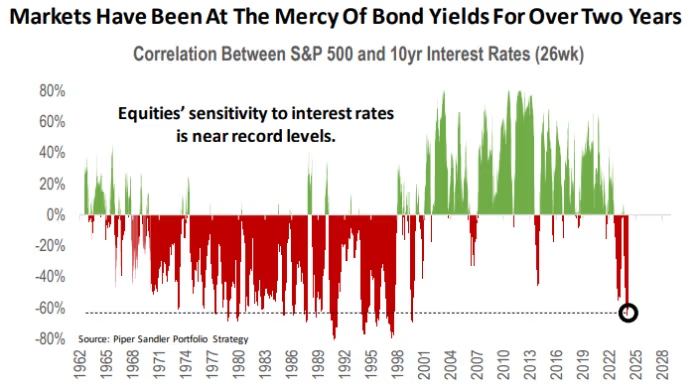A team of investment strategists from Piper Sandler sheds light on the typical triggers behind stock-market corrections, identifying three main culprits: rising unemployment, increasing bond yields, or unexpected global shocks.
The recent surge in the S&P 500, up nearly 30% in five months, has even bullish analysts considering the possibility of a “healthy” correction. However, corrections don’t spontaneously occur; they usually require a catalyst. To anticipate potential triggers for the next significant downturn, Piper Sandler’s Michael Kantrowitz and his team analyzed the 27 corrections of 10% or more for the S&P 500 since 1964.

Their research reveals that each of these corrections was predominantly propelled by one of three factors: escalating unemployment, climbing bond yields, or unforeseen global events. Sometimes, it’s a blend of these factors, as evidenced by the two equity-market corrections in 1980.
So, what’s most likely to initiate the next 10% correction? According to Kantrowitz and team, the primary threat to stable markets is rising bond yields. The most recent correction, ending on October 27 with the S&P 500 down 10.3%, was also triggered by climbing yields.
In the past two years, stocks’ susceptibility to rising yields has soared to levels near those observed at the peak of the dot-com bubble. This suggests that stocks could react negatively to further increases in long-term bond yields, despite their relative immunity to such rises since the beginning of 2024.

Kantrowitz emphasizes that a modest uptick in unemployment could actually benefit the market by acting as a counterforce against rising yields. Typically, bond yields decrease during economic slowdowns as demand for defensive assets like bonds rises.
Last year, stocks experienced a three-month sell-off as Treasury yields surged. The lowest point of the downturn came shortly after the 10-year Treasury yield hit over 5%, a level not seen in 16 years.
Although Treasury yields are once again edging higher in the first quarter, expectations of robust economic growth supporting corporate earnings have so far shielded stocks. The 10-year Treasury note’s yield has risen by 39 basis points since the year began, reaching 4.252%, while the S&P 500 has climbed by 9.4% and 26.7% since the start of the quarter and since October 27, respectively.
Similarly, the Nasdaq Composite is up 9.6% since the beginning of the first quarter, closing at 16,452.69 as of Tuesday, while the Dow Jones Industrial Average has gained 4.5%, or 1,670.79 points, to reach 39,388.56.




